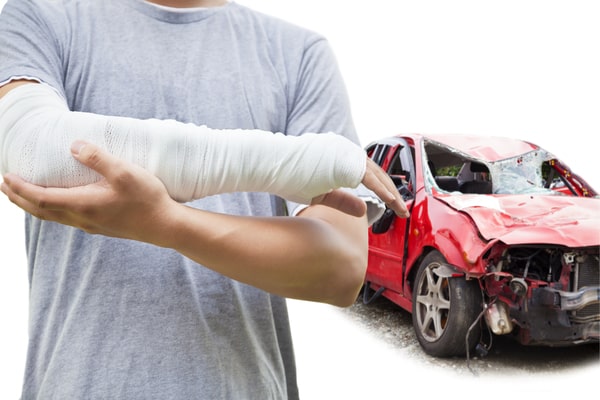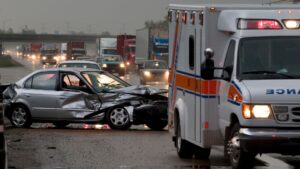
Auto accidents are violent, and it is not uncommon for someone to walk away from a motor vehicle accident with one or more fractures and broken bones. You do not even need to be in a high-speed incident to suffer a fracture. Instead, it is all about the impact the accident has on your body and the type of collision.
Due to the force of the collision on your body, you can fracture bones just from the whipping motion, objects striking you from inside the car, or even from the airbag. In a more catastrophic accident, the vehicle itself could cause crushing injuries, including broken bones.
A Fracture Versus a Broken Bone – What Is the Difference?
Fractures are the same as broken bones, and they are used interchangeably. Both refer to a disruption to your bone’s structure, and the specific type of break is more important than using the term “fracture” or “break.”
What Are the Most Commonly Seen Fractures from an Auto Accident?
Multiple types of bone breaks can occur in a motor vehicle accident, but some are more commonly seen than others. These types of breaks include:
- Tibia Fracture – A broken leg is quite common in a motor vehicle accident. Most people instinctively put their foot on the break as they are about to collide with another vehicle, and being in that position at the time of impact can lead to a broken leg.
- Femur Fracture – Femur fractures are also quite common and one of the most painful fractures anyone can experience. They take longer to heal, often require surgery, and they can leave a person with chronic pain and disabilities. The femur is one of the strongest bones in the body, holding the weight of your upper body. In a high-impact collision, it is also one of the more commonly fractured bones.
- Rib Fracture – Rib fractures are common, and they can occur just from wearing a seatbelt or being struck by your airbag.
- Hip Fracture – A hip fracture is incredibly painful, and they are one of the more common fractures as well, especially when you consider the force that the center of the body takes on during a collision.
- Pelvis Fracture – Pelvis fractures are not only painful and common, but they can be life-threatening. A fractured pelvis can lead to internal bleeding and often require surgery for correction.
- Facial and Skull Fracture – The impact of an airbag is severe, and it is common for a person to suffer from multiple facial fractures. Also, in a high-speed accident, a person’s head and neck are whipped around quite violently, which can lead to a skull fracture and possibly a traumatic brain injury in the process.
- Wrist Fractures – As you hold on to your steering wheel, the impact between the vehicle and your hands gripping that wheel can lead to a wrist fracture. Also, you can fracture a wrist when holding onto a steering wheel when your airbag deploys.
- Arm Fracture – Arm fractures are also common from holding the steering wheel, trying to brace yourself, or being crushed by the vehicle.
- Fractured Disks – Your spinal disks are prone to fracture in an accident, especially if you are involved in a head-on or rear-end collision instead of a side one.
- Clavicle Fracture – Your clavicle is incredibly delicate compared to other bones in the body, and the twisting motion, the pressure of your seatbelt, and even the impact of an airbag can all lead to a fracture of that bone.
Can You Get Compensation for Broken Bones after an Auto Accident?
Absolutely, and you should. While bones might heal, that does not mean you will be 100 percent following the accident. Even if you are able to recover and return to your life as it was, the process of recovering from fractured bones is painful, lengthy, and expensive. You will not only have emergency room care, but you may require orthopedic surgery to correct deformations. You could suffer from permanent pain and nerve damage and require physical therapy to regain your strength after extended periods of immobility.
In more severe fractures, there could be permanent damage. You may be disabled or worse, paralyzed, depending on the severity of the break. Skull fractures that also include a traumatic brain injury could leave a person with permanent deficits – unable to resume life as it was before the accident.
You should not have to shoulder the heavy financial burden for your medical care after an accident; instead, the person who caused that collision is financially responsible for your losses.
Just some of the compensation you may be entitled to includes:
- Lost Wages – You are most likely going to miss work while you recover from your fractures, and if you become permanently disabled, you could lose your ability to make a living entirely. You can request compensation for lost wages while you recover, do follow-up appointments, or loss of earning capacity if you no longer can resume making the income you were prior to the accident.
- Medical Expenses – By far, the biggest part of your compensation will be your medical expenses. You may have emergency room visits, hospitalizations, surgeries, follow-up appointments, specialist appointments, and physical therapy. You will have medical equipment, prescription medications, and you could exhaust your health insurance benefits in a matter of weeks. All of these are compensable.
- Pain and Suffering – The physical pain and emotional trauma of the accident also warrant compensation. You should receive compensation for the mental anguish and physical pain you must endure as you recover from your profoundly serious injuries.
Hire an Attorney to Seek Compensation for Your Broken Bones following a Motor Vehicle Accident Now
If you or a loved one were involved in a serious accident and you suffered broken bones as a result, you may be entitled to compensation. To explore your options, contact a local accident attorney. The team at Brett McCandlis Brown & Connor, PLLC, can help. We have helped dozens of families and their loved ones get the compensation they deserve after a serious accident.
Call us now to schedule a free case evaluation or contact us online with your questions.


